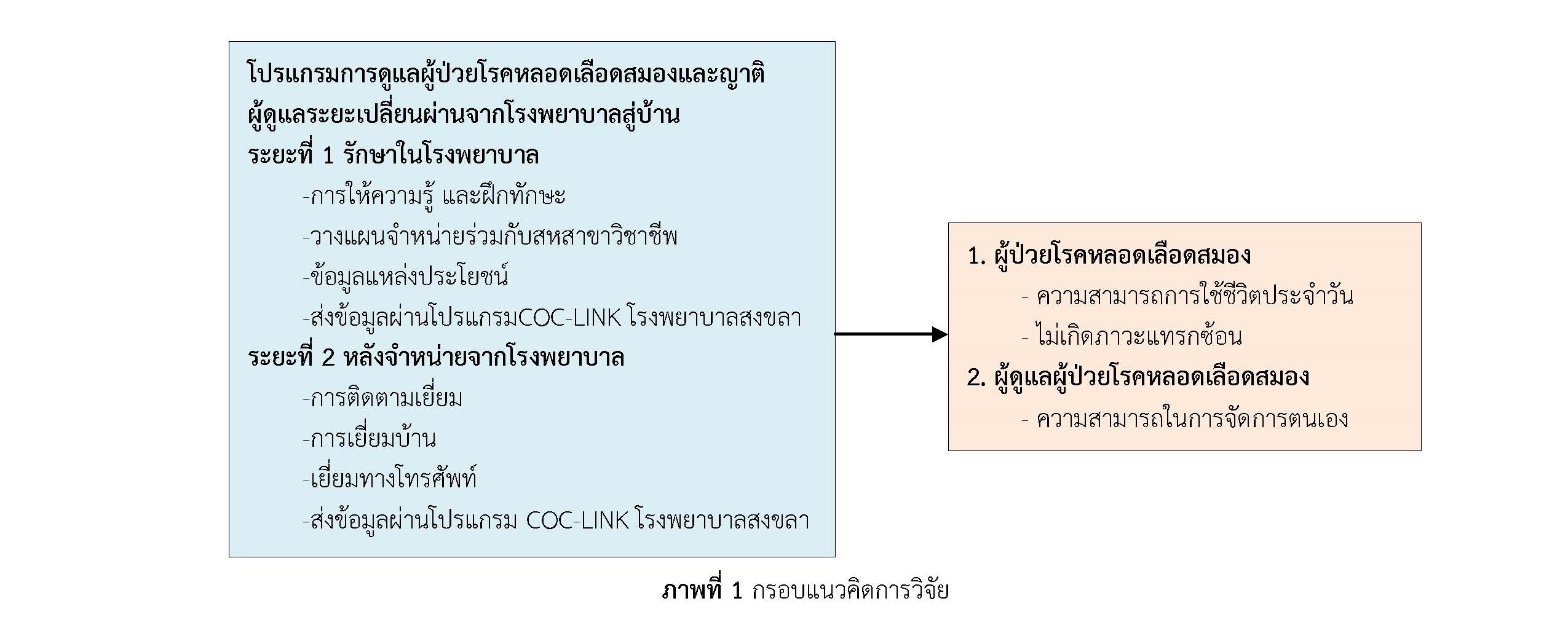Effects of a Hospital-to-Home Transitional Care Program on Activities of Daily Living, Patients’ Complications, and Self-Management Ability of Caregivers
Keywords:
Hospital-to-Home Transitional Care Program, Activities of Daily Living, Self-Management Ability, Patients with Stroke, CaregiversAbstract
This one group pretest-posttest quasi-experimental research aimed to examine the effects of a hospital-to-home transitional care program on activities of daily living, patients’ complications, and self-management ability of caregivers, Songkhla Hospital. Sample were 34 patients with stroke and their caregivers who were admitted to the stroke unit, Songkhla Hospital from March to September 2021. Samples were purposefully chosen based on research criteria. Research instruments consisted of the hospital-to-home transitional care program, the Barthel activities of daily living index, and a self-management ability questionnaire. The Item-Objective Congruence Index (IOC) ranged from 0.67-1.00, and the Cronbach alpha coefficient of self-management ability questionnaire was 0.88. Data were analyzed using descriptive statistics, a dependent t-test, and the Wilcoxon signed ranks test.
The results were found as follows: 1) after program completion, patients with stroke had significantly higher activities of daily living than before enrolling to the program (p-value = 0.001) 2) after program completion, there were no patients’ complications after hospital discharge 3) after program completion, caregivers had significantly higher self-management ability than before enrolling to the program (p-value < 0.001). Therefore, the hospital-to-home transitional care program should be applied to other departments for patients before hospital discharge and it should be extended to community hospitals for continuous care of patients with stroke.
References
กนกวรรณ ช้างโรจน์, ละเอียด แจ่มจันทร์ และจินตนา อาจสันเที๊ยะ. (2563). ผลของการใช้โปรแกรมวางแผนการจำหน่ายตามแนวคิด M-E-T-H-O-D ต่อความสามารถของผู้ดูแลผู้ป่วยโรคหลอดเลือดสมอง. วารสารวิทยาลัยพยาบาลบรมราชชนนี อุตรดิตถ์, 12(2), 223-239.
กรมการแพทย์ กระทรวงสาธารณสุข. (2561). แนวทางการประเมินสถานพยาบาลด้านโรคหลอดเลือดสมอง.สืบค้นเมื่อ 23 กรกฎาคม 2565 จาก https://www.dms.go.th/backend//Content/Content_File/Old_Content/dmsweb/publish/ publish28062019110601.pdf.
กรมการแพทย์ กระทรวงสาธารณสุข. (2564). คู่มือการคัดกรองและประเมินสุขภาพผู้สูงอายุ พ.ศ. 2564. สืบค้นเมื่อ 23 มกราคม 2565 จาก http://www.tako.moph.go.th/takmoph2016/ file_download/file_20210129131952.pdf.
ธีรนุช ห้านิรัติศัย และปริญญา แร่ทอง. (2556). การรับรู้ความพร้อมของผู้ดูแลผู้ป่วยโรคหลอดเลือดสมอง. วารสารวิทยาศาสตร์และเทคโนโลยี, 21(7 ฉบับพิเศษ), 634-639.
โบตั๋น บุญฮู้. (2563). ผลของโปรแกรมการส่งเสริมการเปลี่ยนผ่านต่อความมั่นใจและการเผชิญปัญหาในการเปลี่ยนผ่านของภาวะสุขภาพในผู้ป่วยโรคหลอดเลือดสมองตีบที่เป็นครั้งแรก. วิทยานิพนธ์พยาบาล ศาสตรมหาบัณฑิต สาขาวิชาการพยาบาลผู้ใหญ่ คณะพยาบาลศาสตร์, มหาวิทยาลัยคริสเตียน.
ประคอง อินทรสมบัติ และคณะ. (2556). การดูแลผู้ป่วยสูงอายุที่รับไว้ในโรงพยาบาลอย่างครบวงจรและต่อเนื่อง: การดูแลระยะเปลี่ยนผ่านจากโรงพยาบาลสู่บ้าน. รามาธิบดีพยาบาลสาร, 19(2), 194-205.
ปรารถนา วัชรานุรักษ์ และอัจฉรา กลับกลาย. (2560). ปัจจัยที่มีอิทธิพลต่อพฤติกรรมการป้องกันโรคในผู้ป่วยกลุ่มเสี่ยงโรคหลอดเลือดสมอง จังหวัดสงขลา. วารสารเครือข่ายวิทยาลัยพยาบาลและการสาธารณสุขภาคใต้, 4(1), 217-231.
ยุพาพิน ศิรโพธิ์งาม, สุปรีดา มั่นคง และสิริรัตน์ ลีลาจรัส. (2559). การประเมินประสิทธิผลของโปรแกรมการดูแลผู้ป่วยโรคหลอดเลือดสมอง และญาติผู้ดูแลในระยะเปลี่ยนผ่านจากโรงพยาบาลสู่บ้าน. วารสารพยาบาลสาธารณสุข, 30(3), 84-101.
วันเพ็ญ พิชิตพรชัย และอุษาวดี อัศดรวิเศษ. (2545). การวางแผนจำหน่ายผู้ป่วย: แนวคิดและการประยุกต์ใช้. กรุงเทพฯ: คณะพยาบาลศาสตร์ มหาวิทยาลัยมหิดล.
วาสนา มูลฐี, สุปรีดา มั่นคง, ยุพาพิน ศิรโพธิ์งาม และสิริรัตน์ ลีลาจรัส. (2559). ผลของโปรแกรมการดูแลผู้ป่วยโรคหลอดเลือดสมองและญาติผู้ดูแลระยะเปลี่ยนผ่านจากโรงพยาบาลสู่บ้านต่อความสามารถในการปฏิบัติกิจวัตรประจำวันภาวะแทรกซ้อน และความพึงพอใจของผู้ป่วย. วารสารสภาการพยาบาล, 31(1), 95-110.
วีรวัฒน์ จิตจูง. (2561). การพัฒนาโปรแกรมส่งเสริมสมรรถนะของผู้ดูแลผู้ป่วยโรคหลอดเลือดสมองโรงพยาบาลวิเชียรบุรี จังหวัดเพชรบูรณ์. วิทยานิพนธ์สาธารณสุขศาสตรดุษฎีบัณฑิต
อรุณ จิรวัฒน์กุล. (2556). ชุดความรู้สถิติ. นนทบุรี: สำนักวิชาการสาธารณสุข กระทรวงวสาธารณสุข.
Camak, D. J. (2015). Addressing the burden of stroke caregivers; A literature review. Journal of Clinical Nursing, 24(17-18), 2376-2382. https://doi.org/10.1111/jocn.12884.
Cheng, H. Y., Chair, S. Y., & Pak-ChunChau, Y. (2014). The effectiveness of psychosocial interventions for stroke family caregivers and stroke survivors: A systematic review and meta-analysis. Patient Education and Counseling, 95(1), 30-44.
Edsberg, L. E., et al. (2016). Revised National Pressure Ulcer Advisory Panel Pressure Injury Staging System: Revised Pressure Injury Staging System. Journal Wound Ostomy Continence Nurse, 43(6), 585-597.
Faul, F., Erdfelder, E., Lang, A. G., & Buchner, A. (2007). G*Power 3: A flexible statistical power analysis program for the social, behavioral, and biomedical sciences. Behavior Research Methods, 39(2), 175-191.
Meleis, A. I., Sawyer, L. M., Im, E. O., Messias, D. K., & Schumacher, K. (2000). Experiencing transitions: An emerging middle-range theory. Advances in Nursing Science, 23(1), 12-28.
Naylor, M. D. & Keating, S. A. (2008). Transitional care: Moving patients from one care setting to another. The American Journal of Nursing, 108(9 Suppl), 58-63.
Naylor, M. D. (2002). Transitional care of older adults. In P. Archbold, & B. Stewart (Eds.), Annual Review of Nursing Research. New York: Spinnger.
Naylor, M. D., Brooten, D., Campbell, R. L., Maislin, G., McCauley, K. M., & Schwartz, J. S. (2004). Transitional care of older adults hospitalized elders: A randomized controlled trial. Journal American Geriatrics Society, 52, 675-684.
Orem, D. E. (1991). Nursing Concepts of Practice (4thed.). St.Louis: Mosby Year Book.
Qiu, X., Sit, W. H. J., & Koo, K. F. (2018). The influence of Chinese culture on family caregivers of stroke survivors: A qualitative study. Clinical Nursing, 27(1-2), e309-e319. https://doi.org/10.1111/jocn.13947.

Downloads
Published
How to Cite
Issue
Section
License
Copyright (c) 2022 Journal of Nursing and Public Health Research

This work is licensed under a Creative Commons Attribution-NonCommercial-NoDerivatives 4.0 International License.
1. บทความหรือข้อคิดเห็นใด ๆ ที่ปรากฏในวารสารวิจัยการพยาบาลและการสาธารณสุข ที่เป็นวรรณกรรมของผู้เขียน บรรณาธิการไม่จำเป็นต้องเห็นด้วย
2. บทความที่ได้รับการตีพิมพ์ถือเป็นลิขสิทธิ์ของ วารสารวิจัยการพยาบาลและการสาธารณสุข







